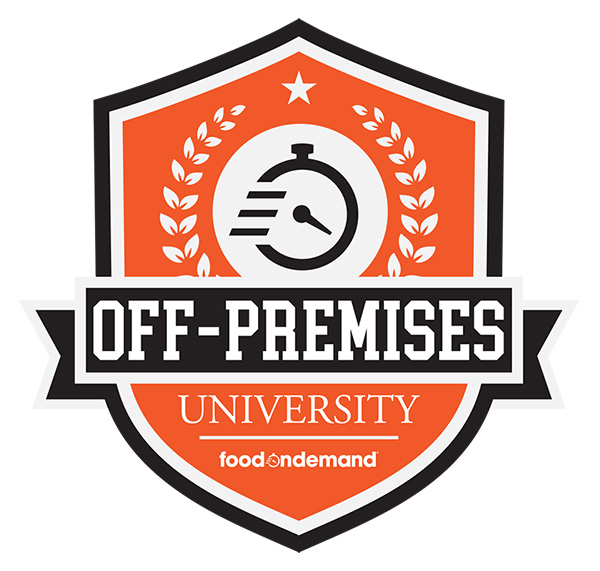Biscuit Bar co-CEO Janie Burkett shared what it took to wrangle her high-volume delivery business and land on numerous best-of lists. First, have really, absurdly good food.
“The HOSS, it’s the biscuit that started the whole thing. It’s a biscuit topped with buttermilk fried chicken, gravy, jack cheese and honey butter,” said Burkett. “The HOSS is my dad, that’s what our kids called him. Unfortunately, he passed a few months before our first store opened, but it’s our No. 1-selling biscuit, my dad’s legend lives on in biscuit form.”
Her No. 2 best seller, a decadent French toast biscuit (a day-old biscuit soaked in vanilla custard and griddled) topped with fried chicken and syrup [swoon]. No. 3 is a classic bacon, egg and cheese biscuit.
She said there are some salads, too, as something for the delivery customer who wants a something lighter, avoiding that veto vote and offering Burkett herself a healthier option.
“We also have really good salads, that’s more selfish than anything. I eat there all the time and I can’t have the HOSS three times a day,” said Burkett.
Across the six current Biscuit Bar locations, the company does a lot of delivery. At her Deep Ellum location, a trendy, artsy and dense neighborhood in Dallas, she sees about 30 percent of her business go out via delivery drivers.
She has a few smart operational tactics, but the second key to really thriving on delivery was changing her mindset to value the delivery customer, potentially more than the in-house diner.
“I hear people say we’re glad to have the to-go business but the person in our dining room is our priority. We have the opposite philosophy,” said Burkett. “The person receiving our item from a third party is just as important than someone in the dining room. One, they paid more—it was more expensive for them. No. 2, if I mess up something in the dining room, I can fix it and enhance the experience.”
Delivery orders, on the other hand, need to be perfect, otherwise, “not only does that hurt our chance to get that person as our loyal customer into our store, but really it can ruin your day,” said Burkett.
She shared a few operational tactics that proved essential. First, having the right tech stack. She said she moved to Olo from another integrator that had only one third-party integration. She said the jump in orders was noticeable immediately after switching over.
In the kitchen, everything is digital, with delivery orders and in-house orders coming to the same window. She said splitting those orders back up in her expo line between in-house and off-premises orders made things easier on staff and enhanced both sides of the business. Each part of the business has a dedicated person, and their own end of the line.
“In the expo line, the to-go orders go toward one side and the dine-in goes to the other side. That was really pivotal for us, we made that change six or eight months ago. That made such a difference,” said Burkett. “The to-go order, which tend to be larger, might be a 10-minute ticket time and a biscuit and gravy is maybe one minute.”
To make those larger orders seamless, she also limited what sort of modifiers were available to delivery customers. Changes slowed down the whole kitchen. When an employee saw something especially odd, it made them pause and break the rhythm of banging out HOSS sandwiches to figure it out. Burkett was especially inspired by one very strange modification.
“I was in expo I looked at it and said, ‘What!?’ It was a Monte Cristo—a French toast biscuit with ham, turkey, strawberry jam and jack cheese. The wanted to take out the meat, add peppers, a sausage patty and mustard. First, no, that sounds terrible,” said Burkett. “Nobody should put peppers on a Monte Cristo.”

The two Biscuit Bar bundles, in the brand’s lovely custom packaging.
Apart from messing up the flow in the kitchen, the gross-out factor could mean a bad customer experience. Customers can still get peppers on their sandwich in the restaurant, but with a focus on a great delivery experience, she said it was up to her to limit their potentially insane culinary desires.
Lastly, she found ways to productize larger orders. She sells two boxes of biscuit sandwiches. One is the Biscuit 2X4, a $50 box with four pairs of matching specialty biscuits. Then there’s the BEC Brick, a $40 box of eight bacon, egg and cheese biscuits. She also has a Biscuit Bundle, just eight biscuits, a mason jar of gravy and a jar of preserves. She said during peak order times, those bundles keep the kitchen moving and keep order times in line without complex group orders wreaking havoc on the staff.
She said she’s on track to keep growing the brand, and is keeping a laser focus on exceptional delivery operations.




